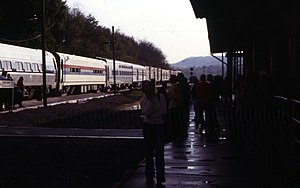Three Rivers (train)
This article needs additional citations for verification. (March 2009) |
 The Three Rivers at Lewistown in 2002. | |||||||||||||||||||||||||||||||||||||||||||||||||||||||||||||||||||||||||||||||||||||||||||||||||||||||||||||||||||||||||||||||||||||||||||||||||||||||||||||||||||||||||||||||||||||||||||||||||||||||||||||||||||||||||||||||||||||||||||||
| Overview | |||||||||||||||||||||||||||||||||||||||||||||||||||||||||||||||||||||||||||||||||||||||||||||||||||||||||||||||||||||||||||||||||||||||||||||||||||||||||||||||||||||||||||||||||||||||||||||||||||||||||||||||||||||||||||||||||||||||||||||
|---|---|---|---|---|---|---|---|---|---|---|---|---|---|---|---|---|---|---|---|---|---|---|---|---|---|---|---|---|---|---|---|---|---|---|---|---|---|---|---|---|---|---|---|---|---|---|---|---|---|---|---|---|---|---|---|---|---|---|---|---|---|---|---|---|---|---|---|---|---|---|---|---|---|---|---|---|---|---|---|---|---|---|---|---|---|---|---|---|---|---|---|---|---|---|---|---|---|---|---|---|---|---|---|---|---|---|---|---|---|---|---|---|---|---|---|---|---|---|---|---|---|---|---|---|---|---|---|---|---|---|---|---|---|---|---|---|---|---|---|---|---|---|---|---|---|---|---|---|---|---|---|---|---|---|---|---|---|---|---|---|---|---|---|---|---|---|---|---|---|---|---|---|---|---|---|---|---|---|---|---|---|---|---|---|---|---|---|---|---|---|---|---|---|---|---|---|---|---|---|---|---|---|---|---|---|---|---|---|---|---|---|---|---|---|---|---|---|---|---|---|---|---|---|---|---|---|---|---|---|---|---|---|---|---|---|---|---|
| Service type | Inter-city rail | ||||||||||||||||||||||||||||||||||||||||||||||||||||||||||||||||||||||||||||||||||||||||||||||||||||||||||||||||||||||||||||||||||||||||||||||||||||||||||||||||||||||||||||||||||||||||||||||||||||||||||||||||||||||||||||||||||||||||||||
| Status | Discontinued | ||||||||||||||||||||||||||||||||||||||||||||||||||||||||||||||||||||||||||||||||||||||||||||||||||||||||||||||||||||||||||||||||||||||||||||||||||||||||||||||||||||||||||||||||||||||||||||||||||||||||||||||||||||||||||||||||||||||||||||
| Locale | Northeastern United States Midwestern United States | ||||||||||||||||||||||||||||||||||||||||||||||||||||||||||||||||||||||||||||||||||||||||||||||||||||||||||||||||||||||||||||||||||||||||||||||||||||||||||||||||||||||||||||||||||||||||||||||||||||||||||||||||||||||||||||||||||||||||||||
| Predecessor | Broadway Limited | ||||||||||||||||||||||||||||||||||||||||||||||||||||||||||||||||||||||||||||||||||||||||||||||||||||||||||||||||||||||||||||||||||||||||||||||||||||||||||||||||||||||||||||||||||||||||||||||||||||||||||||||||||||||||||||||||||||||||||||
| First service | September 10, 1995 | ||||||||||||||||||||||||||||||||||||||||||||||||||||||||||||||||||||||||||||||||||||||||||||||||||||||||||||||||||||||||||||||||||||||||||||||||||||||||||||||||||||||||||||||||||||||||||||||||||||||||||||||||||||||||||||||||||||||||||||
| Last service | March 7, 2005 | ||||||||||||||||||||||||||||||||||||||||||||||||||||||||||||||||||||||||||||||||||||||||||||||||||||||||||||||||||||||||||||||||||||||||||||||||||||||||||||||||||||||||||||||||||||||||||||||||||||||||||||||||||||||||||||||||||||||||||||
| Successor | Pennsylvanian | ||||||||||||||||||||||||||||||||||||||||||||||||||||||||||||||||||||||||||||||||||||||||||||||||||||||||||||||||||||||||||||||||||||||||||||||||||||||||||||||||||||||||||||||||||||||||||||||||||||||||||||||||||||||||||||||||||||||||||||
| Former operator(s) | Amtrak | ||||||||||||||||||||||||||||||||||||||||||||||||||||||||||||||||||||||||||||||||||||||||||||||||||||||||||||||||||||||||||||||||||||||||||||||||||||||||||||||||||||||||||||||||||||||||||||||||||||||||||||||||||||||||||||||||||||||||||||
| Route | |||||||||||||||||||||||||||||||||||||||||||||||||||||||||||||||||||||||||||||||||||||||||||||||||||||||||||||||||||||||||||||||||||||||||||||||||||||||||||||||||||||||||||||||||||||||||||||||||||||||||||||||||||||||||||||||||||||||||||||
| Start | New York City | ||||||||||||||||||||||||||||||||||||||||||||||||||||||||||||||||||||||||||||||||||||||||||||||||||||||||||||||||||||||||||||||||||||||||||||||||||||||||||||||||||||||||||||||||||||||||||||||||||||||||||||||||||||||||||||||||||||||||||||
| Stops | 19 | ||||||||||||||||||||||||||||||||||||||||||||||||||||||||||||||||||||||||||||||||||||||||||||||||||||||||||||||||||||||||||||||||||||||||||||||||||||||||||||||||||||||||||||||||||||||||||||||||||||||||||||||||||||||||||||||||||||||||||||
| End | Chicago, Illinois | ||||||||||||||||||||||||||||||||||||||||||||||||||||||||||||||||||||||||||||||||||||||||||||||||||||||||||||||||||||||||||||||||||||||||||||||||||||||||||||||||||||||||||||||||||||||||||||||||||||||||||||||||||||||||||||||||||||||||||||
| Distance travelled | 908 miles (1,461 km) | ||||||||||||||||||||||||||||||||||||||||||||||||||||||||||||||||||||||||||||||||||||||||||||||||||||||||||||||||||||||||||||||||||||||||||||||||||||||||||||||||||||||||||||||||||||||||||||||||||||||||||||||||||||||||||||||||||||||||||||
| Average journey time | 19 hours 30 minutes | ||||||||||||||||||||||||||||||||||||||||||||||||||||||||||||||||||||||||||||||||||||||||||||||||||||||||||||||||||||||||||||||||||||||||||||||||||||||||||||||||||||||||||||||||||||||||||||||||||||||||||||||||||||||||||||||||||||||||||||
| Service frequency | Daily | ||||||||||||||||||||||||||||||||||||||||||||||||||||||||||||||||||||||||||||||||||||||||||||||||||||||||||||||||||||||||||||||||||||||||||||||||||||||||||||||||||||||||||||||||||||||||||||||||||||||||||||||||||||||||||||||||||||||||||||
| Train number(s) | 40, 41 | ||||||||||||||||||||||||||||||||||||||||||||||||||||||||||||||||||||||||||||||||||||||||||||||||||||||||||||||||||||||||||||||||||||||||||||||||||||||||||||||||||||||||||||||||||||||||||||||||||||||||||||||||||||||||||||||||||||||||||||
| Technical | |||||||||||||||||||||||||||||||||||||||||||||||||||||||||||||||||||||||||||||||||||||||||||||||||||||||||||||||||||||||||||||||||||||||||||||||||||||||||||||||||||||||||||||||||||||||||||||||||||||||||||||||||||||||||||||||||||||||||||||
| Rolling stock | |||||||||||||||||||||||||||||||||||||||||||||||||||||||||||||||||||||||||||||||||||||||||||||||||||||||||||||||||||||||||||||||||||||||||||||||||||||||||||||||||||||||||||||||||||||||||||||||||||||||||||||||||||||||||||||||||||||||||||||
| Track gauge | 4 ft 8+1⁄2 in (1,435 mm) | ||||||||||||||||||||||||||||||||||||||||||||||||||||||||||||||||||||||||||||||||||||||||||||||||||||||||||||||||||||||||||||||||||||||||||||||||||||||||||||||||||||||||||||||||||||||||||||||||||||||||||||||||||||||||||||||||||||||||||||
| Track owner(s) | Amtrak Conrail (Until 1999) Norfolk Southern CSXT | ||||||||||||||||||||||||||||||||||||||||||||||||||||||||||||||||||||||||||||||||||||||||||||||||||||||||||||||||||||||||||||||||||||||||||||||||||||||||||||||||||||||||||||||||||||||||||||||||||||||||||||||||||||||||||||||||||||||||||||
| |||||||||||||||||||||||||||||||||||||||||||||||||||||||||||||||||||||||||||||||||||||||||||||||||||||||||||||||||||||||||||||||||||||||||||||||||||||||||||||||||||||||||||||||||||||||||||||||||||||||||||||||||||||||||||||||||||||||||||||
The Three Rivers was a daily Amtrak train running between New York City and Chicago, Illinois. It operated via Philadelphia, Pennsylvania, Pittsburgh, and Akron, Ohio. The Three Rivers replaced the Broadway Limited in 1995. The route was cancelled, with the last train running on March 7, 2005, due to Amtrak's unilateral cancellation of a United States Postal Service contract on the line.[1]
Service east of Pittsburgh continues to be provided by the Pennsylvanian. Stations previously served between Pittsburgh and Hammond–Whiting are bereft of passenger trains, though the Capitol Limited provides service between Pittsburgh and Chicago via Cleveland, Ohio.
History[]
Amtrak began the Three Rivers on September 10, 1995, as a replacement for the discontinued Broadway Limited. Originally the train ran between New York and Pittsburgh, extending a New York—Harrisburg, Pennsylvania Keystone Service. It carried the numbers 46/47. In Pittsburgh, the train exchanged mail cars with the Chicago—Washington, D.C. Capitol Limited. Passengers continuing to Chicago changed trains. Through service began on February 1, 1996: two Three Rivers Amfleet coaches were coupled to the Superliner consist of the Capitol Limited. Through passengers reached the Capitol Limited portion of the train via the transition dorm.[2]: 27
Amtrak ended the switching operation on November 10, 1996, in favor of extending the Three Rivers to Chicago as an independent train. Amtrak restored the Broadway Limited's numbers (40/41), but because of equipment shortages could not restore sleeper service not a full dining car. Operating at the height of Amtrak's experiment with mail and express business, a typical late 1990s Three Rivers carried 4-6 passenger cars and upwards of 25 mail cars.[2]: 31
Station stops[]
At the outset, the Three Rivers stopped at Pittsburgh, Greensburg, Johnstown, Altoona, Huntingdon, Lewistown, Harrisburg, Lancaster, Paoli, Philadelphia, Trenton, Newark and New York. With the extension to Chicago in 1996, service began to Hammond-Whiting and Nappanee. Service to the intermediate Ohio stations began after those cities funded station improvements: Youngstown (May 16, 1997), Fostoria (December 15, 1997) and Akron (August 10, 1998). Amtrak added Latrobe as a flag stop on May 17, 1998.[2]: 35
Route[]
Highlights along the run included Horseshoe Curve near Altoona, Pennsylvania Dutch Country, and the Allegheny Mountains. The entire trip took about 20 hours.
Consist[]
The Three Rivers used Amfleet coaches and either Amfleet or Horizon dinettes. Amtrak never assigned a full dining car owing to equipment shortages and an unfavorable schedule. Starting on April 1, 1999 Amtrak began assigning a Heritage Fleet sleeper to the Three Rivers. No Viewliners were available; Amtrak refurbished four stored Heritage sleepers for $250,000. These were the last standard 10-6 sleepers in Amtrak operation and required a Federal Railroad Administration waiver to operate because of their direct-dump toilets. When this waiver expired in October 2001 Amtrak retired the Heritage sleepers and replaced them with Viewliners, which were now available.[2]: 35
References[]
- ^ "The final Three Rivers service rolls through Ohio, Indiana". Associated Press. 2005.[permanent dead link]
- ^ a b c d Sanders, Craig (2006). Amtrak in the Heartland. Bloomington, Indiana: Indiana University Press. ISBN 978-0-253-34705-3.
External links[]
- Former Amtrak routes
- Railway services introduced in 1995
- Railway services discontinued in 2005
- Transportation in Pittsburgh
- Passenger rail transportation in Pennsylvania
- Passenger rail transportation in New York (state)
- Passenger rail transportation in New Jersey
- Passenger rail transportation in Ohio
- Passenger rail transportation in Indiana
- Passenger rail transportation in Illinois